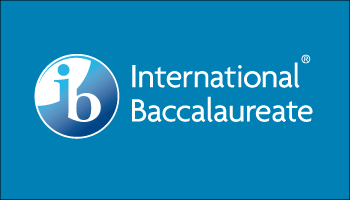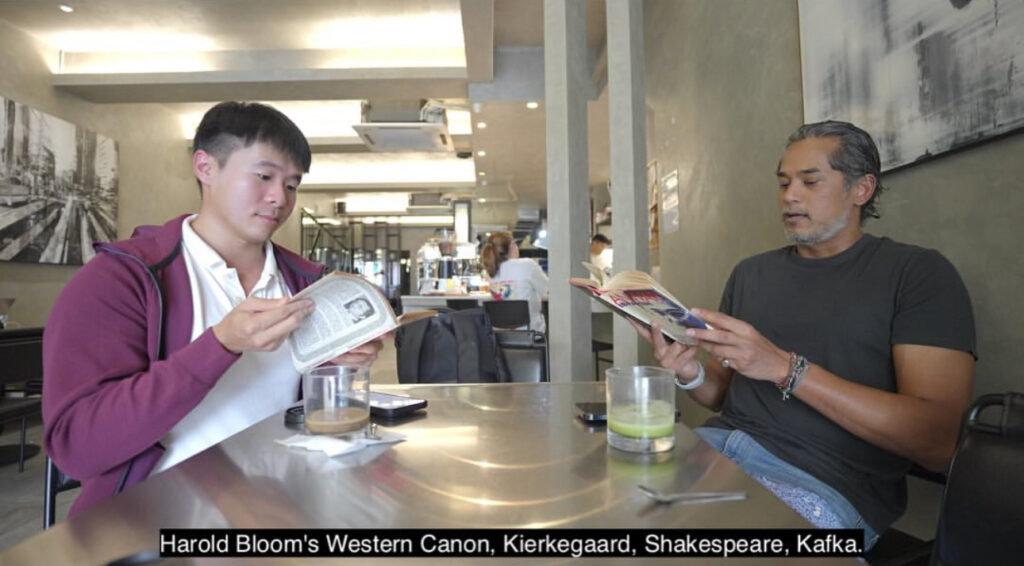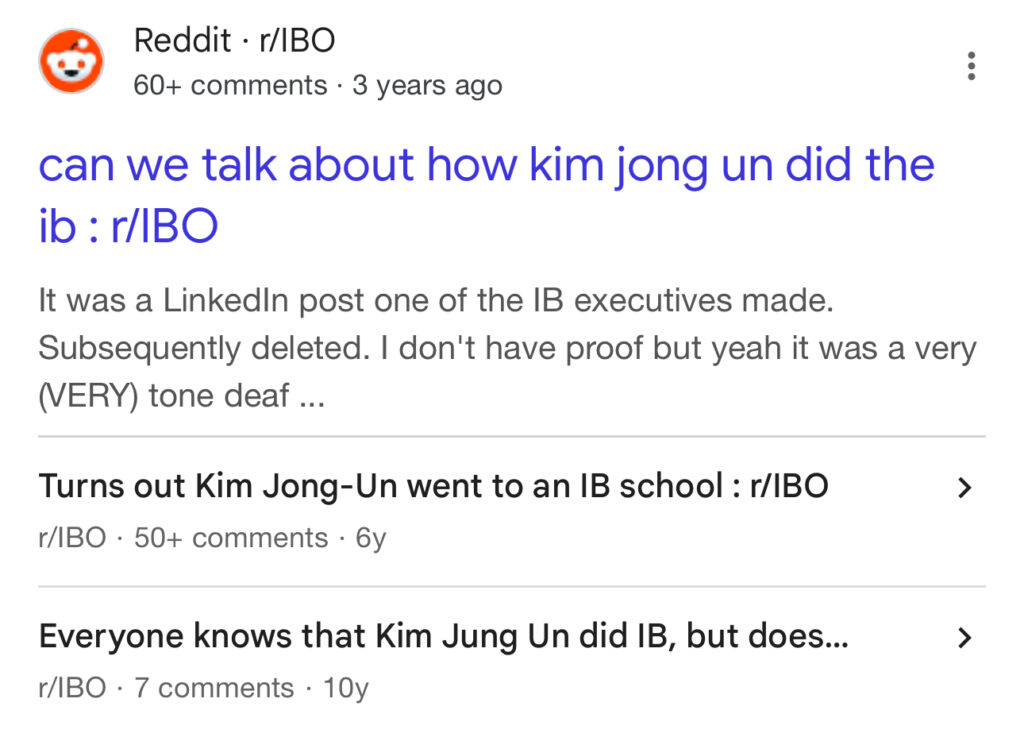Sepupus, we’ve come to the last part of the focus of this website beyond which an open world lies. Here we are at the program that I did, the International Baccalaureate Diploma Program.

Of all the major pre-university programs, I think that this is probably one of the most misunderstood – But there are a couple of people out there whom you might not expect to have done it, but whose names you will recognize regardless.
Amongst others, you have Khairy Jamaluddin, who did his IB aeons ago (and who did an extended essay on FELDA, interestingly enough), as he discussed with me when we did our interview together last year…

And also… Kim Jong-un? The current supreme leader of North Korea, otherwise known as the Democratic People’s Republic of Korea, who allegedly did his IB in Switzerland where the thing was actually conceived?

Well, maybe that’s just conventional wisdom or the results of a tabloid rag gone wow. But it would be fascinating to imagine him struggling over a HL math exam 😅
Anyway, IB is a globally recognized two-year educational framework tailored for students aged 16-19, and it is a little different from A levels which tend to go a lot more into depth into individual subjects in that it emphasizes holistic learning, international-mindedness, and developing inquiring people capable of critical thinking and responsible global citizenship – Which pretty much any IB student could easily tell you just means that we are extremely extremely good at BSing, but I’ll leave it to you to discover what’s true and what’s not.
If you’re doing the IB, maybe you can even make it into a TOK question.
You’re welcome.
Anyway…
Educational Philosophy of the IB Diploma Programme
Every educational organization has some sort of underpinning philosophy behind it, and the IB is no different. What it promised seemed a little more appealing to me at the time, though, and this is what it was.

You can also read this document here created by the IB if you are interested.
Didn’t read that? No problem – here are my thoughts and experiences.
I could say any number of woke things about the IB diploma, but I think that that’s a disservice to you, so I will just say my thoughts.
As I understand it, the International Baccalaureate (IB) is designed to be an international qualification. It was designed to be a curriculum that was interoperable, whichever international school you went to throughout the world, and it was designed with that explicit idea of broad focus and worldly scope in mind – To create something for the children of diplomats across the world so that whichever international school they went into, they would be able to just slot themselves in and just function, work, and do well.
To that end, students take six subjects which is meant to offer an education in breadth – three at what we call higher level and three at standard level. A higher level is roughly equivalent to an A level in terms of scope, while SLs are more analogous to AS exams. Also, there are a couple of interesting assessments, namely…
- Theory of Knowledge (TOK), which explores the nature of knowledge and how we come to know what we know.
- Extended Essay (EE), which involves an independent research project of 4000 words, fostering depth of inquiry.
- Creativity, Activity, Service (CAS) encourages students to engage in extracurricular activities to nurture personal growth and community service.
Economics within the IB Diploma Programme
Now, this sets us out to understand economics within the IB Diploma.
Economics within the IB DP focuses not only on economic theories and models but also on their real-world application, ethical implications, and societal impacts, and with an eye towards internationalism.
Curriculum and Content
Economics students at both Higher Level (HL) and Standard Level (SL) study four core units:
- Introduction to Economics: We study foundational principles and economic thinking, Leading from scarcity into the principles of economics.
- Microeconomics: We study individual market behaviors, supply-demand analysis, and market failures, amongst other things.
- Macroeconomics: national economies, policy-making, and economic indicators like GDP, GDP per capita, as well as phenomena that affect the macro economy, i.e., the economies of countries, such as inflation and the interest rate, and how all this affects the aggregate behavior of consumers.
- The Global Economy: international trade, economic integration, sustainable development, and economic growth.
As with Economics at IGCSE and A level, understanding content knowledge is important, but so is the ability to analyze and to evaluate, although the topics may be slightly different or the emphasis somewhat shifted. We will talk a little bit more about this later on.
The difference between SL and HL in terms of content is that HL goes much more into depth. For example, in HL economics, students go deep into the Theory of the Firm and into cost curves amongst other things, the Marshall-Lerner condition, and a lot more depth in terms of discussions and understanding of economic theory. Also, there is an explicit focus on policy analysis and evaluation which is manifested in paper 3 which is only available for HL students.
📚 IB Economics Assessment Structure: HL vs SL
STANDARD LEVEL (SL)
🔸 Internal Assessment (30%)
- Content: Three commentaries (800 words each) based on real-world news articles. This will probably be a big source of your suffering throughout the course, and I will talk more about it later on.
- Coverage: One each for microeconomics, macroeconomics, and global economics.
- Assessment method: Internally marked, externally moderated. What this means in practice is that all of you will be working with your economics teachers to craft and create your commentaries. In most schools, you will have the chance to have your teacher look over a draft one time so that you can receive comments before having to submit the final.
What typically happens is that the teacher will assign grades to every single person, and IB won’t be checking every single assignment for marking. Rather, what they do is choose one or two commentaries from the entire cohort, compare what they personally would grade the IAS against the teacher’s grade, and then from there try to understand how the school is doing.
If the school grades the commentary very leniently and assigns it a perfect score when in reality it should have only deserved a 5, then this raises an alarm bell that tells us that the school is too lenient and therefore all other students should be treated as such.
🔸 External Assessment (70%)
- Paper 1 (Essay-based) – Extended analytical and evaluative responses, requiring critical thinking and deep synthesis across economic theories. Basically, you need to bring out your analysis and evaluation skills here alongside your understanding of real-world examples. By this point, I hope that you’ve read a lot and have taken the effort to learn about the world around you, countries around you, and economic decisions and how they impact the world around you.
- Paper 2 (Data-response) – Application and analysis of data sets to examine economic concepts practically.
| Paper | Type | Time | Description | Weight |
|---|---|---|---|---|
| 1 | Extended Response | 1 hour 15 min | Choose one question from three. Each question has part (a) and part (b). | 30% |
| 2 | Data Response | 1 hour 45 min | Choose one question from two. Based on real-world case study extracts. | 40% |
🕒 Total Examination Time: 3 hours
📘 Syllabus Coverage: Core syllabus only (units 1–4)
HIGHER LEVEL (HL)
🔹 Internal Assessment (20%)
- Content: Same as SL — three 800-word commentaries from different syllabus sections.
- Assessment method: Internally marked, externally moderated – Same as before.
🔹 External Assessment (80%)
- Paper 1 and 2 – Same as for SL.
- Paper 3 (Policy paper) – A specialized assessment exclusively for HL, focusing explicitly on policy evaluation and synthesis.
| Paper | Type | Time | Description | Weight |
|---|---|---|---|---|
| 1 | Extended Response | 1 hour 15 min | Same structure as SL — one out of three essays (two parts each) | 20% |
| 2 | Data Response | 1 hour 45 min | Same as SL — one out of two case-based questions | 30% |
| 3 | Policy Analysis | 1 hour 45 min | Answer two compulsory questions — includes mathematical calculations. | 30% |
🕒 Total Examination Time: 4 hours 45 minutes
📗 Syllabus Coverage: Core + HL extensions (includes more advanced theory and quantitative work)
🎯 Summary: SL vs HL
| Feature | SL | HL |
|---|---|---|
| Papers | 2 (P1 & P2) | 3 (P1, P2, P3) |
| Internal Assessment | 30% | 20% |
| Quantitative Paper | ❌ | ✅ (Paper 3) |
| Syllabus | Core topics only | Core + HL extensions |
| Total Exam Duration | 3 hours | 4 hours 45 minutes |
| University Preparation | Moderate | Strong (especially for economics/finance) |
Philosophy and Practical Differences between HL and SL
HL Economics aims to prepare students rigorously for university-level economics study. It provides deeper theoretical foundations, more extensive analytical challenges, and greater demands for synthesis and evaluation. The additional HL-exclusive policy paper reflects this heightened focus.
SL Economics, while rigorous, is tailored for students seeking a strong but general understanding of economics. It balances foundational theory with practical applications suitable for students whose higher education or career aspirations lie in diverse fields beyond economics itself.
Similarities and the Unique Contribution of the IB
Regardless of whether you are taking SL or HL economics, it’s a good bet that you will be expected to:
- Read widely
- Manage your time extremely well because of the multiple other assignments and subjects you are dealing with
- Be able to comment intelligently and link things together across different areas of the syllabus
- Make good observations about what’s suitable
One of the reasons why the IB happens to be one of the most expensive pre-university programs that a person can undertake is because of the high labor intensity of this kind of engagement, whereby teachers have to often deal with entire cohorts of students on a personal basis to provide feedback to every single student in the course of their journey, which is not easy by any means and entails a large amount of work.
I consider it a very rewarding programme, but let me go ahead and tell you that it really isn’t for everyone, because it’s not an easy programme and if you don’t choose the right school, you will suffer because of the way the curriculum is structured and because of how much contact time and therefore collaboration you as a student will need to have with your teachers.
I know some of you will read this and you will say that you want a more rigorous education – Well that was exactly what I wanted; let me not overly praise or mock my teachers, but let me just say that it would be fair to say that I went on to hard mood. And up until now I still don’t know whether I can justify it.
To that, I can say the following: Be careful what you wish for because you may actually receive it.
…Then again, you’re here reading Sepupunomics, are you not? Well… Enjoy your masochism then, I guess.😂
Alright, sepupus, that’s enough for today, and I will see you in the next one!
